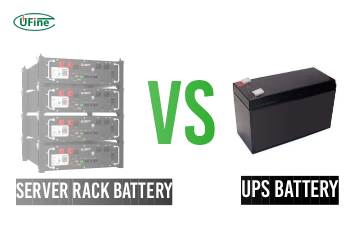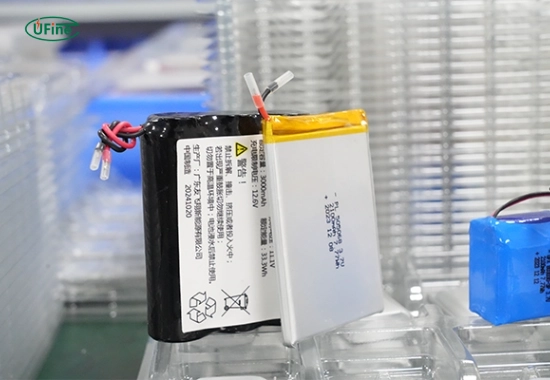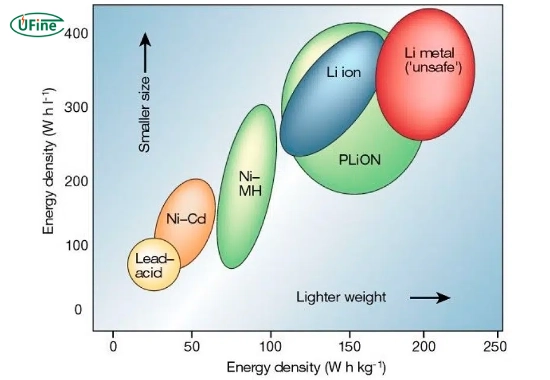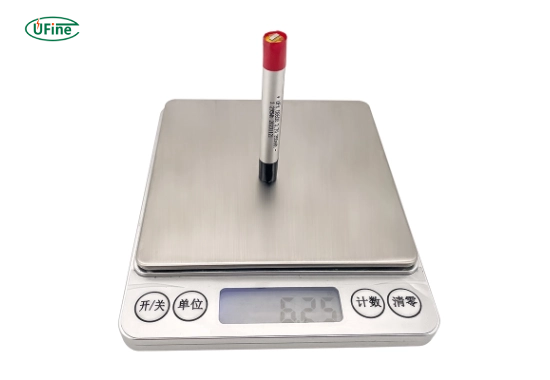
- Part 1. What is a lithium battery and how does it work?
- Part 2. What does energy density mean in batteries?
- Part 3. Why does lithium battery weight matter?
- Part 4. Lithium battery weight vs energy density chart
- Part 5. How lithium chemistry affects both energy density and battery weight?
- Part 6. What’s the best chemistry for weight-sensitive applications?
- Part 7. Future technologies: solid-state and lithium-sulfur
- Part 8. How to calculate energy density from battery specs
- Part 9. Lithium battery weight vs lead-acid: a clear winner
- Part 10. Tips when selecting a battery based on weight and energy density
- Part 11. FAQs about lithium battery weight and energy density
What is the relationship between lithium battery weight and energy density? The answer lies in the chemistry of the battery itself. Some lithium batteries are lighter but store less energy, while others are heavier but pack in more power per unit. Understanding this balance is essential when choosing a battery for your electric vehicle, solar system, or mobile device.
In this comprehensive guide, we’ll explore how battery chemistry affects weight and energy density, compare different lithium types, and help you make informed decisions using real data, charts, and clear explanations. If you’re looking for a lightweight yet powerful battery, this guide is your go-to resource.
Part 1. What is a lithium battery and how does it work?
A lithium battery is a rechargeable energy storage device that uses lithium ions to move between the cathode and anode to store and release energy. It’s one of the most common battery types in modern electronics, from smartphones and laptops to electric vehicles and solar storage units.
Here’s how it works in simple terms:
- During charging, lithium ions move from the cathode to the anode.
- During discharging, the ions return to the cathode, releasing electrical energy.
The magic lies in lithium’s light atomic weight and high electrochemical potential, which allow these batteries to store more energy in a smaller, lighter package.
Part 2. What does energy density mean in batteries?
Lithium battery energy density measures how much energy a battery can store relative to its weight or size.
There are two main types:
- Gravimetric energy density (Wh/kg): Energy per kilogram of battery.
- Volumetric energy density (Wh/L): Energy per liter of battery volume.
High gravimetric energy density = more energy with less weight.
This is critical for mobile and electric-powered applications where weight directly impacts performance, such as electric vehicles, drones, and portable electronics.
Part 3. Why does lithium battery weight matter?
The weight of a lithium battery influences both performance and efficiency, especially in motion-based systems.
Here’s why:
- Electric vehicles (EVs): Lighter batteries improve acceleration, reduce energy consumption, and extend range.
- Drones: Lower weight increases flight time and maneuverability.
- Portable electronics: Users prefer lightweight devices that can run longer on a single charge.
- Marine / RV systems: Lighter batteries reduce overall vehicle weight, improving fuel efficiency.
Choosing a battery with a high energy-to-weight ratio can dramatically enhance usability and operational efficiency.
Part 4. Lithium battery weight vs energy density chart
Let’s compare popular lithium battery chemistries based on energy density and weight. This chart will help you visualize how much energy you can get per kilogram, and how that translates into real-world applications.
| Battery Chemistry | Gravimetric Energy Density (Wh/kg) | Weight per 1kWh (kg) | Common Use Cases |
|---|---|---|---|
| Lithium Iron Phosphate (LiFePO₄) | 90–160 | 6.5–11 | Solar, RVs, off-grid backup |
| Lithium Cobalt Oxide (LCO) | 150–200 | 5–6.6 | Smartphones, laptops |
| Lithium Nickel Manganese Cobalt (NMC) | 150–220 | 4.5–6.6 | EVs, power banks |
| Lithium Titanate (LTO) | 50–80 | 12.5–20 | Industrial, grid storage |
Key insight: The lighter the battery, the higher the energy density, but some chemistries trade off safety and lifespan for weight.
Part 5. How lithium chemistry affects both energy density and battery weight?
The chemistry inside a lithium battery directly determines both its weight and how much energy it can store. Different chemical compositions have unique characteristics that affect the energy-to-weight ratio.
Let’s take a closer look at how each chemistry influences weight and energy density:
1. Lithium Iron Phosphate (LiFePO₄)
- Energy Density: 90–160 Wh/kg
- Weight: Heavier for the same capacity
- Why Heavier? It uses iron and phosphate, which are denser materials.
- Advantage: Extremely safe, long cycle life (>4000 cycles), thermally stable.
- Drawback: Lower energy density = more weight for same output.
- Best for: Stationary systems, solar storage, RVs — where weight is less critical.
2. Lithium Cobalt Oxide (LCO)
- Energy Density: 150–200 Wh/kg
- Weight: Relatively light
- Why Lighter? High cobalt content boosts voltage and energy storage.
- Advantage: High energy in a compact, lightweight size.
- Drawback: Shorter cycle life, more expensive, less stable under high loads.
- Best for: Mobile devices where space and weight are premium.
3. Lithium Nickel Manganese Cobalt (NMC)
- Energy Density: 150–220 Wh/kg
- Weight: Very lightweight per kWh
- Why Efficient? Balanced composition gives high capacity without excess mass.
- Advantage: High energy density and good safety.
- Drawback: Slightly lower lifespan than LiFePO₄.
- Best for: EVs, scooters, energy-dense portable systems.
4. Lithium Titanate (LTO)
- Energy Density: 50–80 Wh/kg
- Weight: Very heavy per kWh
- Why Heavy? Uses titanium-based anodes, which are denser.
- Advantage: Extremely fast charging and very long lifespan (>10,000 cycles).
- Drawback: Low energy density = bulky and heavy.
- Best for: Industrial, grid-level storage, and military-grade applications.
Part 6. What’s the best chemistry for weight-sensitive applications?
If weight is your top concern, you’ll want a battery with the highest possible gravimetric energy density.
| Use Case | Best Chemistry | Why |
|---|---|---|
| Drones & RC Devices | LCO | Lightweight, high energy per gram |
| Electric Vehicles | NMC | High energy, good efficiency |
| Portable Power Banks | NMC or LCO | Compact, high output |
| RV / Solar Storage | LiFePO₄ | Safety, long life, weight less important |
Part 7. Future technologies: solid-state and lithium-sulfur
New battery technologies aim to increase energy density while reducing weight.
Solid-State Lithium Batteries
- Replaces liquid electrolyte with solid material.
- Potential Energy Density: Up to 500 Wh/kg.
- Benefits: Safer, more compact, lighter.
Lithium-Sulfur Batteries
- Uses sulfur as a cathode material.
- Potential Energy Density: Over 600 Wh/kg.
- Challenges: Shorter lifespan (currently in research phase).
These could revolutionize electric flight and long-range EVs by drastically reducing battery weight.
Part 8. How to calculate energy density from battery specs
To compare batteries directly, you can calculate real-world energy density:
Energy density (Wh/kg) = Total Watt-hours / Battery weight in kg
Example:
- A 12V 100Ah LiFePO₄ battery = 1200Wh
- Weight = 11 kg
- Energy density = 1200 / 11 = 109 Wh/kg
This allows you to compare batteries from different brands or chemistries quickly and accurately.
Part 9. Lithium battery weight vs lead-acid: a clear winner
| Parameter | Lithium (LiFePO₄) | Lead-Acid |
|---|---|---|
| Weight | 60–70% lighter | Very heavy |
| Usable Capacity | 90–95% | 50% (deep discharge reduces life) |
| Lifespan | 2000–5000 cycles | 300–500 cycles |
| Maintenance | None | Regular maintenance |
Lithium batteries weigh much less and last far longer than lead-acid batteries, making them more cost-effective over time.
Part 10. Tips when selecting a battery based on weight and energy density
- Check Wh/kg or calculate it yourself.
- Prioritize chemistry based on your application.
- Don’t forget safety, lifespan, and cost.
- Use a higher density battery for mobile or weight-sensitive needs.
- Avoid overpaying for energy you don’t need.
Part 11. FAQs about lithium battery weight and energy density
What is the most energy-dense lithium battery?
Currently, NMC and LCO chemistries have the highest commercial energy densities, reaching up to 220 Wh/kg.
Which lithium battery is the lightest per kWh?
The NMC battery typically offers the lightest weight per kWh, often requiring 4.5–6.6 kg to store 1 kWh of energy.
Why does battery chemistry affect weight so much?
Different chemistries use different materials (like cobalt, iron, or titanium), that vary in mass and how efficiently they store energy, directly influencing the battery’s weight.
Are lighter batteries always better?
Not always. Heavier batteries like LiFePO₄ may offer greater safety and lifespan, which can be more important in stationary or long-term use cases.
Can I reduce the weight of my solar system by switching to lithium?
Yes. Replacing lead-acid with lithium can cut battery weight by 50–70%, while also increasing usable capacity and reducing maintenance.
Related Tags:
More Articles

Server Rack Battery vs UPS Battery: What’s the Difference
Discover the difference between server rack and UPS batteries. Compare design, chemistry, performance, and maintenance to select the best data center backup.
How to Choose the Right Server Rack Battery for Your Data Center?
Find out how to choose the right server rack battery for your data center. Consider capacity, runtime, safety, and compatibility for reliable backup power.
What Is a Server Rack Battery? A Complete Guide for Data Centers and IT
Discover what a server rack battery is, how it works, and why it’s essential for reliable data center and IT power backup. Learn key features and benefits.
Understanding the Difference Between AA and AAA Batteries
Wondering about the difference between AA and AAA batteries? Learn the key differences, similarities, and when to use each in this detailed guide.
3S LiPo Batteries Explained – How to Pick the Best 3S Battery
This guide includes 3S voltage charts, capacity options, life, safety rules, and top recommended batteries — so you can choose the best 3S LiPo battery.





